Art & Exhibitions
New York Gallery Beat: 5 Critics Review 12 Shows
With Assume Vivid Astro Focus, portraits from Ukraine, and a new Bushwick gallery.
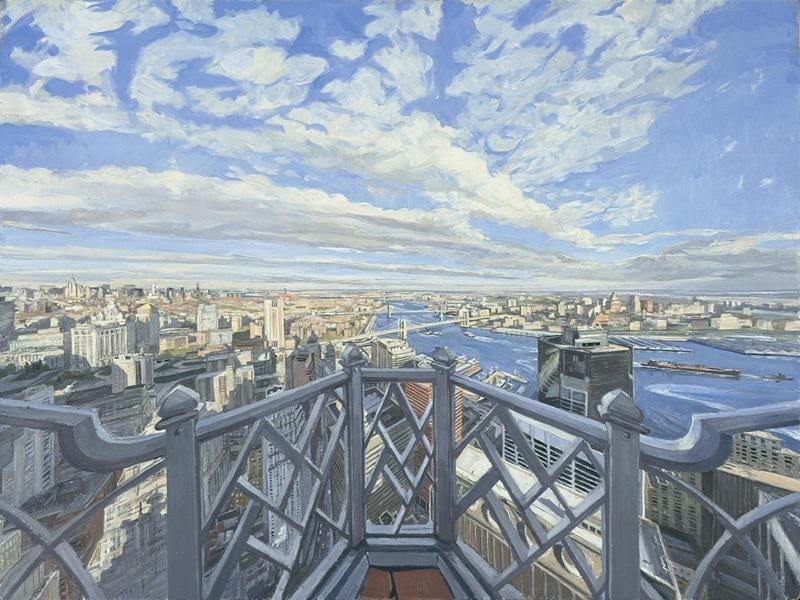
With Assume Vivid Astro Focus, portraits from Ukraine, and a new Bushwick gallery.

Artnet News

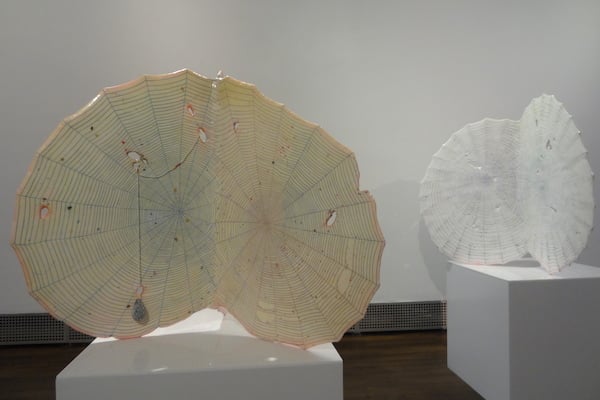
Works by Dani Tull at On Stellar Rays.
Photo: Benjamin Sutton.
“13 Essential Rules for Understanding the World” at On Stellar Rays, closes June 21
The centerpiece of this four-artist show—a collaboration between the longtime LES gallery, Dubai’s The Third Line, and Dubai-based collector Rajat Malhotra—is Basim Magdy’s titular video from 2011, which juxtaposes soothing footage of cartoon faces drawn on tulip petals with a list of harsh truisms including, “Never try to change anything, you can’t even change yourself,” and “Never forget there are almost seven billion other people here. You don’t matter. Really, no one cares.” After this bit of deadpan humor, the rest of the exhibition is a jarring grouping of lyrical and colorful works. The most engrossing are Nabil Nahas’s thick, colorful, and vaguely maritime abstract works, and Dani Tull’s intriguing wax-and-acrylic spiderweb tripods. Those pieces, along with a pair of mixed-media works by Zipora Fried, help crystallize the show’s unstated theme of polychromatic pagan mysticism—or, to filter out the International Art English: fun with nature. —Benjamin Sutton
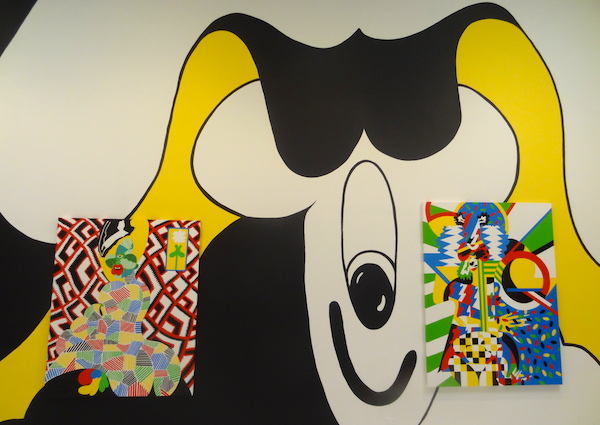
Assume Vivid Astro Focus, “adderall valium ativan focalin (cantilevering me)” installation view.
Photo: Benjamin Sutton.
Assume Vivid Astro Focus at Suzanne Geiss Company, closes June 21
If Picasso had dropped acid before painting Les Demoiselles d’Avignon, the result would have fit right into avaf’s new show. The Franco-Brazilian duo have pushed their hybrid style of glitchy patterns and cartoonish forms backward through modern art history, resulting in a new series of paintings that evoke Cubism and Pop art. Much like the works’ hybrid aesthetic, their subjects are gender-bending anatomical mashups. The rotund figure in Four Balls (2014), for instance, has the lips and hair of a woman, but also, as the title intimates, four sets of testicles. The psychedelic harlequin figure in Cyclops American Evangelist Uganda (2014) sports a similar grab-bag of body parts, along with overgrown armpit hair and fingernails, as it wipes its butt with the US flag. These new works, many of which are hung at irregular heights and intervals over a new black-and-yellow mural in Geiss’s main gallery, appealingly meld grotesque imagery with avaf’s high-production-value practice. —Benjamin Sutton
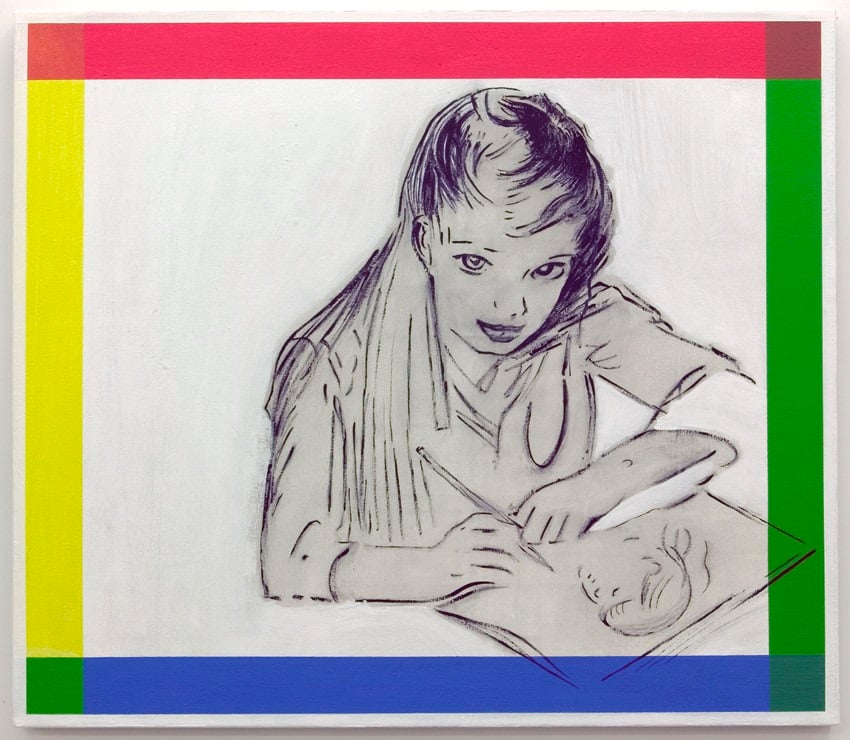
Jason Brinkerhoff
Girl (Drawing), 2014
mixed media on canvas
Courtesy of the artist and ZieherSmith, NY
Jason Brinkerhoff at Ziehersmith, closes June 21
From cartoon-style depictions of little, pig-tailed girls tumbling backwards (think Highlights magazine-style drawings) to Picasso-esque reclining nudes and faces depicted in bold German Expressionism-style lines, Jason Brinkerhoff continues his dogged pursuit of a singular subject, the female form. His second solo show at Ziehersmith is also his first exhibition exclusively featuring work on canvas, rather than works on paper. Though the underlying meaning eludes me, the range of styles and textures Brinkerhoff works in is impressive—not to mention highly enjoyable. —Eileen Kinsella
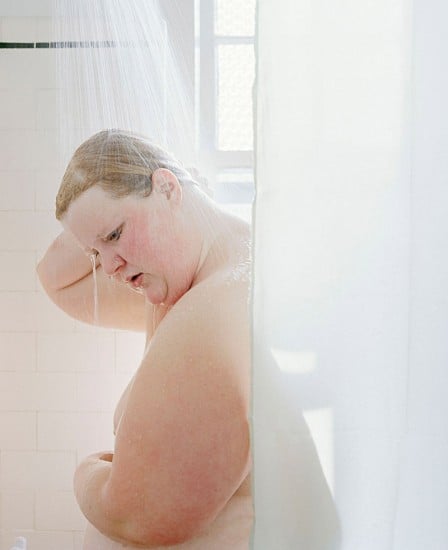
Jen Davis, Untitled No. 29
Jen Davis at ClampArt, closes July 3
“Eleven Years” showcases Jen Davis’s arresting photographs, which have also recently been published in a book under the same name. Davis uses her work to grapple with her own insecurities surrounding body image, as well as the larger issue of societal perceptions of beauty. The self-portraits feature the artist in a variety of situations ranging from the shower to a lover’s embrace to a dining in a restaurant. All of them are tender, human, and extraordinarily well-composed, hinting at an intimate relationship between the artist and the camera. —Cait Munro
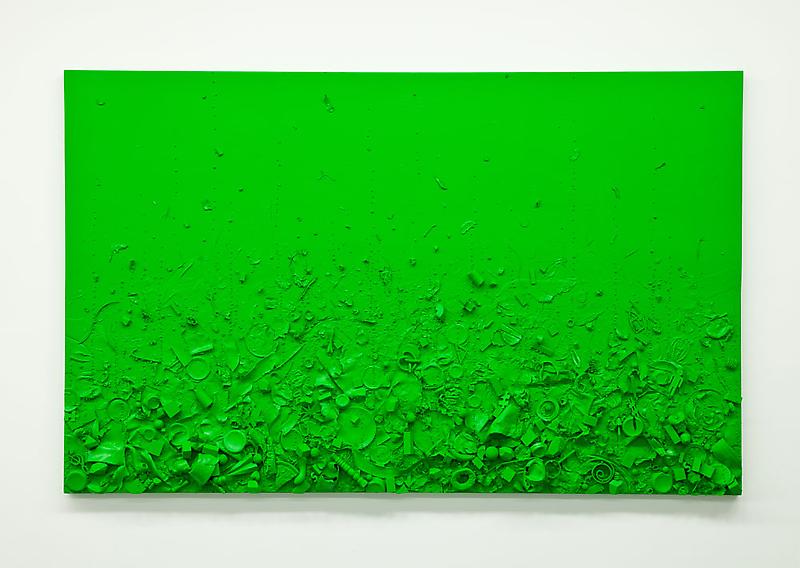
Tom Friedman,
Toxic Green Luscious Green (2014)
Tom Friedman at Luhring Augustine Bushwick, closes August 8
Known for his intricate, often deceptive works and painstaking attention to detail, Friedman’s second solo exhibition with the gallery, “Paint and Styrofoam,” uses everyday objects in a way that transforms them into something otherworldly. The two most successful works, “Blue” and “Toxic Green Luscious Green,” feature bric-a-brac densely clustered on one side of the canvas, appearing to either be floating up or falling down. Painted in eye-popping colors, these colorful messes beg to be inspected, and in doing so you may pick out the form of a hashtag, a puzzle piece, and even a miniature hotdog. Other paintings, while less sculptural and less eye-catching also feature hidden gems, including a painterly homage to Van Gogh’s “Starry Night” that’s not to be missed. —Cait Munro

Sybil Gibson, Face in Space (1993). Photo: courtesy Woodward Gallery.
Sybil Gibson, Woodward Gallery, closes June 21
Woodward Gallery, celebrating its 20th anniversary this year, presents “Art From Within,” an exhibition of work by Alabama folk artist Sybil Gibson (1908–1995). Gibson took up the brush late in life, utilizing acrylic and tempera paint and makeshift canvases of cardboard, newspaper, and grocery bags for her landscapes, portraits, and floral still lifes. Her bold, vibrant colors and free, easy brushstrokes lend an air of refinement to her unconventional materials, but the gallery has somewhat underscored her outsider status with prominently placed quotes by the artist. Gibson describes her process of soaking grocery bags in water and creating “the pictures” with paint that she had previously “used in the classroom with the children.” Another sign of her self-taught background is her signature, which adorns each work in large, childish cursive. The paintings can sometimes be unsettling, featuring blobby people with dark, soulless eyes. Others are more cheerful, straddling the line between childlike whimsy and elegant abstraction. —Sarah Cascone
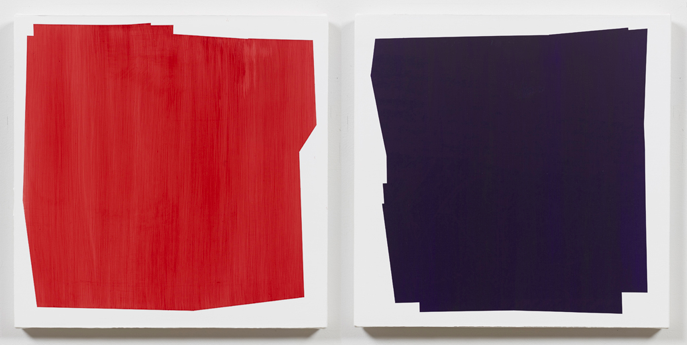
Betsy Kaufman, (l.) Untitled (2013); (r.) Untitled (2013)
Photo: © Betsy Kaufman, courtesy Leslie Tonkonow Artworks + Projects, New York.
Betsy Kaufman at Leslie Tonkonow, closes June 28
“A Story of Red and Other Works,” the abstract painter’s 7th solo show at Leslie Tonkonow, almost inspires an extra-visual lexicon. I wonder what the 18th-century French mathematician Louis-Bertrand Castel, he of the ocular harpsichord, might make of Kaufman’s repetitive, bold strokes of acrylic color on canvas upon smooth wood panels. What color-music would the quadrangular forms of the 39-unit title ensemble play, and how would the triptych Untitled (2013), three angular geometries of white, sound? More scholarly critics than I may speak in congested terms of Kaufman’s link to Walter Benjamin (whom I adore) or her engagement with the grid, but why should this artist be restricted so? —Elizabeth Manus
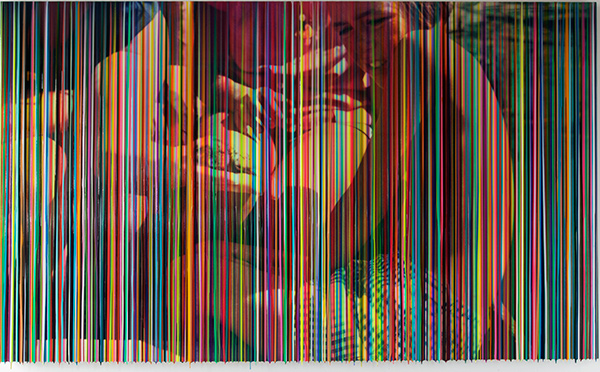
Markus Linnenbrink, MEINWILDESHERZ (2011)
“Opening Day” at Odetta Gallery, closes June 26
Odetta is a new addition to the Bushwick art scene, and the aptly named group show “Opening Day” is its first exhibition. Presenting the work of four mid-career artists, the show is a touch scattered, though it’s likely that because of this, there’s something for everyone. The highlight is the work of Marcus Linnenbrink, a German-born, Bushwick-based artist who has shockingly never shown in his own neighborhood before. His dripping, polychromatic works are made from Epoxy resin and pigments in a variety of forms, ranging from a bench-like structure to a photograph abstracted by the lines of color. They are lively and fun to look at, and stand out as a clear champion of the show. Also worth noting are the dizzying, repetitive line paintings by Rob de Oude, which bring with them a rhythm and sense of motion that thrills the eye. —Cait Munro
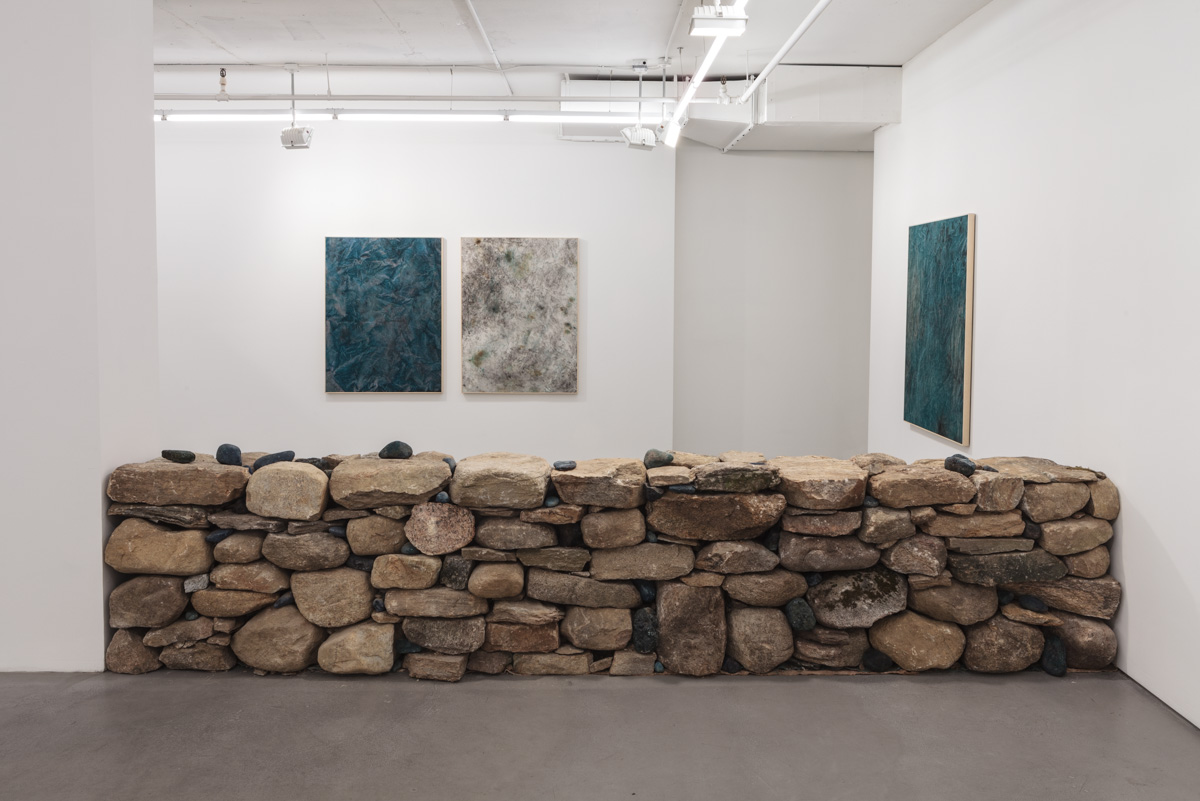
Jaime Sneider at Thierry Goldberg Gallery, installation view. Photo: courtesy Thierry Goldberg Gallery.
Jamie Sneider at Thierry Goldberg Gallery, closes July 3
Entering Jaime Sneider‘s show at Thierry Goldbery Gallery, the viewer is presented with a disconcertingly clinical array of 1700s-era kitchen tools and, ominously, a taxidermied bat displayed in a glass vitrine. On the wall hangs a large painting that at first appears to be in oil, but on closer inspection is revealed to be crumbled cloth stained, dyed, and flattened out. An adjacent hallway leading into the main gallery space is lined with more canvases, each in warm tones. Together, they take on a surprisingly beautiful, almost marble-like appearance. Sneider’s theme, a comparison between New England witches and Puritan homemakers, emerges fully in the back room, which features rustic stone walls. A second vitrine is full of objects of a more sinister nature, including a dead crow, a cauldron, and a vial of inky liquid. The paintings, however, remain the standout, a kind of homespun, old-fashioned tie-dye the artist creates by boiling canvas with dyes such as beets, bleach, urine, and squid ink, weighing it down with rocks and beating it with sticks in a strange amalgamation of cooking and antiquated laundry techniques. —Sarah Cascone
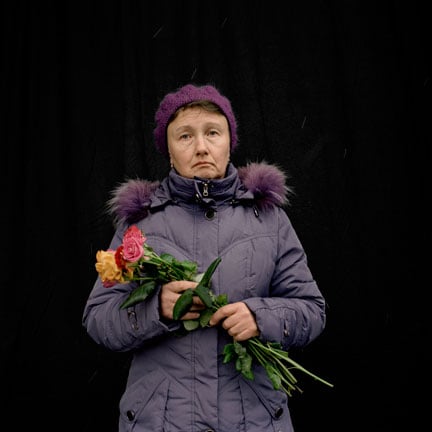
Anastasia Taylor-Lind, Ira, 50 (2014). Photo: courtesy Anastasia Photo.
Anastasia Taylor-Lind at Anastasia Photo, closes August 10
“MAIDAN: Portraits from the Black Square,” Anastasia Taylor-Lind’s debut at Anastasia Photo (despite the shared name, artist and gallery share no prior connection) puts a human face on the recent Ukrainian revolution. A series of portraits of those involved focuses both on the combatants and the loved ones of the 112 confirmed to have died during the conflict. The mourners, who range in age from six months old to 59, carry bouquets in remembrance of the dead, while the revolutionaries sport improvised, makeshift fatigues and body armor. The spontaneous nature of the uprising is evidenced by 25-year-old freedom fighter Tanya’s fingernails, still long and elegant. Taylor-Lind photographed her subjects in a makeshift studio, a simple black cloth hung only a few feet away from the barricades. The transitory setting for the fighters and their families on the site of the battles at Maiden square underscore the raw, fresh nature of the upraising against Viktor Yanukovych, providing New Yorkers a rare personalized glimpse into unrest usually reduced to a headline. —Sarah Cascone
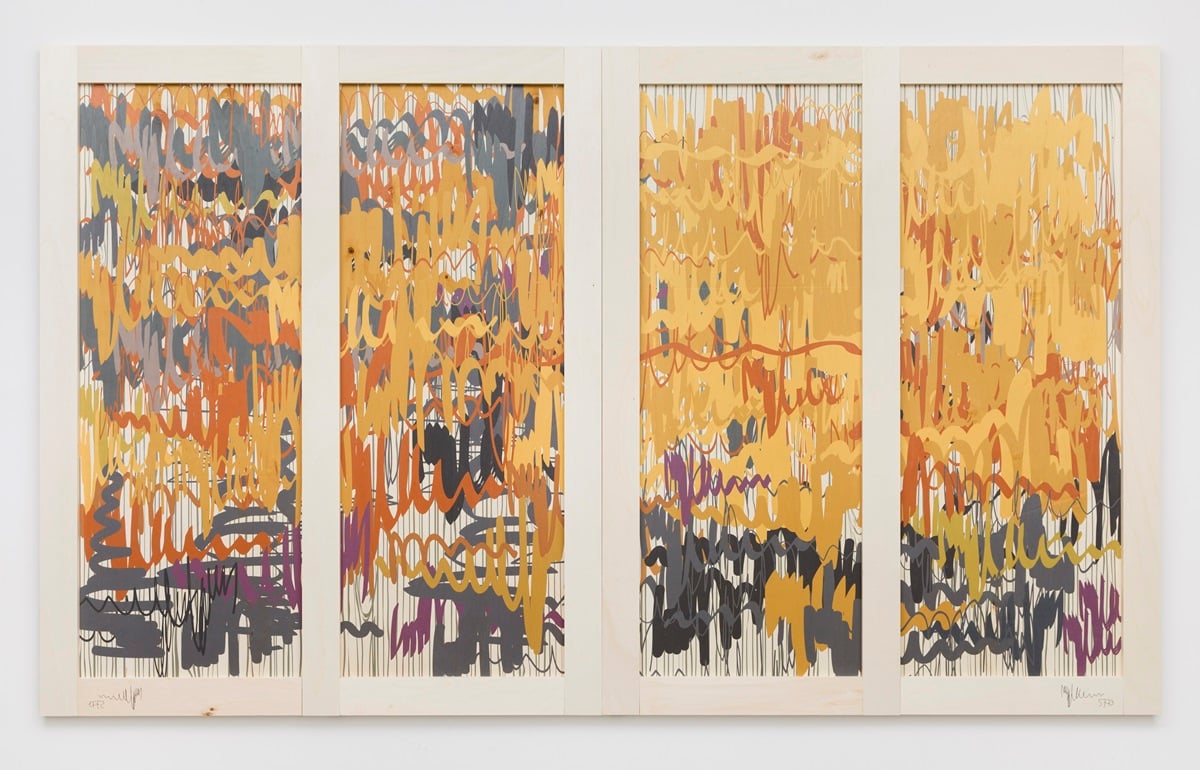
Meyer Vaisman MV111 (2014) Artist’s Signature: llehctiM naoJ, 5773 AGFA UVI inks on poplar plywood. Photo: Courtesy Eleven Rivington, NY
Meyer Vaisman at Eleven Rivington Gallery, closes June 27
Venezuelan-born Meyer Vaisman’s intriguing, highly-finished works, featuring inkjet paintings on industrial plywood, honor his intent to produce paintings without his hand or touch. The paintings are seen backwards, reflected or upside down and with the stretcher bars thus acting as frames. This show, spread across Eleven Rivington’s two lower east side spaces (11 Rivington and 195 Chrystie), marks his first solo show in New York in 14 years. It represents a marked departure from the animal imagery and human representation that was key to his earlier practice. Now his primary motifs are things like his own signature and handwriting. A solo show is scheduled for Portikus in Germany, in 2015. An interesting biographical note – in 1984 Vaisman founded the artist-run gallery International with Monument in the East Village, where he showcased the work of Richard Prince, Jeff Koons, Ashley Bickerton and Sarah Charlesworth. —Eileen Kinsella

John Wonnacott (b. 1940)
New York: Looking to Brooklyn Bridge (2000-2002)
oil on board
Photo: Courtesy the artist, Chambers Fine Art
John Wonnacott at Chambers Fine Art, closes July 5
Wonnacott (b. 1940) is considered one of the UK’s best figurative artists and is closely associated with the group known as the School of London. He graduated from the Slade School of Art in the early 1960s and despite adhering to a working method focused exclusively on direct observation, his works have a postmodern edge to them. It’s ironic that the centerpiece of this show, Wonnacott’s 2013 commission to paint the executives of Jardine Matheson, a British trading company in Hong Kong, is also the dullest, most lifeless aspect of the show. Despite his painterly skill, it’s no fun to look at reverential paintings of stuffy businessmen in stiff, double breasted suits poring over papers at their desks or conversing in an executive office high above the city of Hong Kong with the skyline in the back. Attempts to link the work with 19th-century East India company painter George Chinnery hardly make the subject matter more palatable. Much more interesting are Wonnacott’s city views, including the views of Hong Kong that he painted from his room at the Mandarin Hotel during the Jardine commission visit to Hong Kong, or a New York view of the Brooklyn Bridge (above), and his honest but quirky self-portraits, often taken from unusual perspectives. —Eileen Kinsella